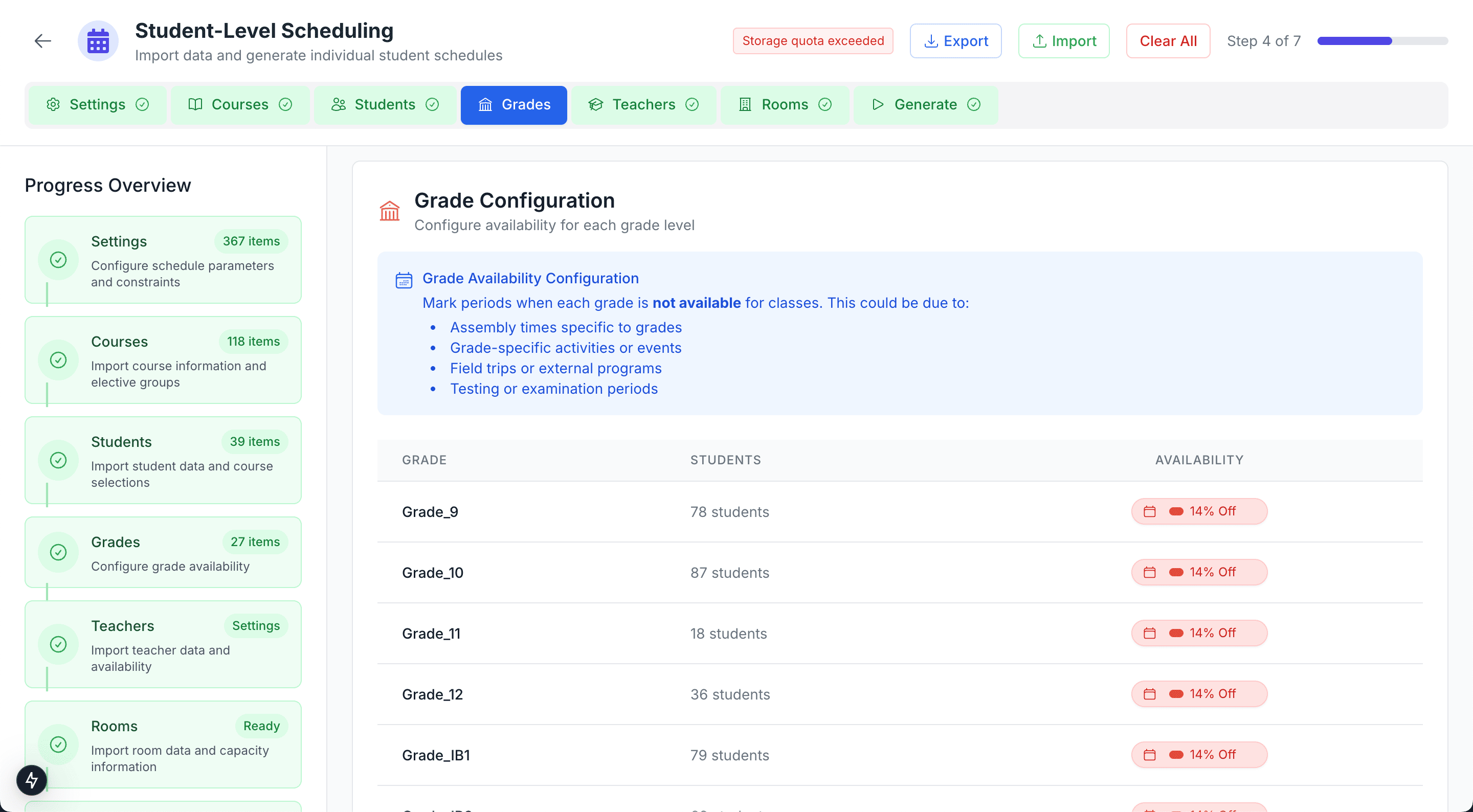Step 4: Grades Configuration
Grades configuration allows you to set specific availability and restrictions for different grade levels. This ensures that grade-level requirements like lunch periods, study halls, and assembly times are properly incorporated into student schedules.
Understanding Grade-Level Scheduling
Different grades often have different scheduling needs and restrictions. The Individual Student Schedule Generator accommodates these variations to create realistic, compliant timetables for all students.

Grades configuration interface showing availability grids
Common Grade-Level Variations
Elementary Grades (K-5):
- Earlier lunch periods
- Longer recess breaks
- Scheduled library and specialist time
- Coordinated movement between classrooms
Middle School Grades (6-8):
- Structured lunch periods
- Advisory or homeroom time
- Exploratory course rotations
- Study hall requirements
High School Grades (9-12):
- Flexible lunch scheduling
- Study periods and free blocks
- Work-study programs
- College preparation periods
Configuring Grade Availability
Period-by-Period Availability
For each grade level, specify which periods are available for course scheduling:
Available Periods: Normal periods where courses can be scheduled
- Mark all periods when students can attend regular classes
- Most periods will be available for most grades
Restricted Periods: Times when specific grades cannot have courses
- Lunch periods (often different times for different grades)
- Assembly periods (may vary by grade level)
- Study hall or advisory time
- Grade-specific activities
Blocked Periods: Times completely unavailable for the grade
- Off-campus programs
- Required testing periods
- Grade-level meetings or activities
Setting Up Grade-Specific Restrictions
Lunch Period Management
Staggered Lunch Times: Different grades eating at different times
- Elementary: Often 11:30 AM - 12:15 PM
- Middle School: Typically 12:00 PM - 12:45 PM
- High School: Usually 12:30 PM - 1:15 PM
Multiple Lunch Periods: Large schools with several lunch shifts
- First lunch, second lunch, third lunch options
- Students assigned based on their course schedules
- Ensures cafeteria capacity isn't exceeded
Lunch Scheduling Strategy: The system will automatically avoid scheduling courses during designated lunch periods for each grade. Students will have consistent lunch times that don't conflict with their academic classes.
Grade Configuration Examples
High School Grade 9 Example:
- Lunch: Period 4 (11:45 AM - 12:30 PM) blocked
- Advisory: Period 1 on Fridays blocked
- All other periods available for courses
Middle School Grade 7 Example:
- Lunch: Period 5 (12:15 PM - 1:00 PM) blocked
- Exploratory Rotation: Period 7 on alternating days blocked
- Study Hall: Period 8 blocked twice per week
Elementary Grade 4 Example:
- Lunch: Period 3 (11:00 AM - 11:45 AM) blocked
- Recess: Period 6 (2:00 PM - 2:30 PM) blocked
- Library: Period 2 on Tuesdays blocked
Impact on Schedule Generation
The system uses grade availability to:
- Avoid scheduling courses during blocked periods
- Ensure students have appropriate lunch and break times
- Respect grade-specific program requirements
- Balance course distribution across available periods
Next Steps
With grade-level availability configured, you're ready to move to Faculty Configuration where you'll set up teacher information, qualifications, and availability.
Quick Checklist:
- All grade levels have appropriate availability periods
- Lunch periods are blocked for correct grades and times
- Special programs and restrictions are accommodated
- Sufficient periods remain available for required courses
- Cross-grade dependencies are considered
- Grade configurations validated successfully